1920 Ocoee Election Day Massacre: Florida museum seeks to shine light on dark day
Image shows July Perry, one of the victims of the Ocoee massacre (Orange County Regional History Center)
ORLANDO, Fla. - After three years of research, weeks of preparations and installations, the Orange County Regional Historical Center has opened a new, in-depth exhibit focusing on a dark part of Florida's history: The Ocoee Election Day massacre, the largest incident of voting-day violence in U.S. history.
On Nov. 2, 1920, a Black man named Moses Norman tried to vote in Ocoee, but was turned away because he allegedly didn't pay his poll taxes. After the polls closed, a mob of armed white men arrived at the home of Norman's friend, July Perry, who was also Black.
The museum's historians say the encounter escalated. Two men in the mob, who were law enforcement officers, were killed. At least four Black people were murdered, including Perry, who was lynched and hung from a tree in public view.
Homes and property owned by Blacks were purposely targeted and burned to the ground.
“Fires are started, there are gunshots, there is just a lot of terror and it is very much a white against Black situation at this point,” explained Pam Schwartz, the museum's chief curator.
The terror didn't end on Nov. 2. It lasted through the years that followed, and was enough to push out all Black individuals in the community.
In fact, the Orange County community, nestled between Orlando and Lake Apopka, was not home to a single African-American for decades after the massacre.
There are hundreds of versions of what occurred that day -- mainly because there was an obvious effort to bury evidence of the events. Other accounts say up to 60 Blacks may have been killed, but museum officials say they can officially confirm only four deaths.
“People intentionally destroyed evidence, did not keep appropriate paperwork and resources,” explained Schwartz.
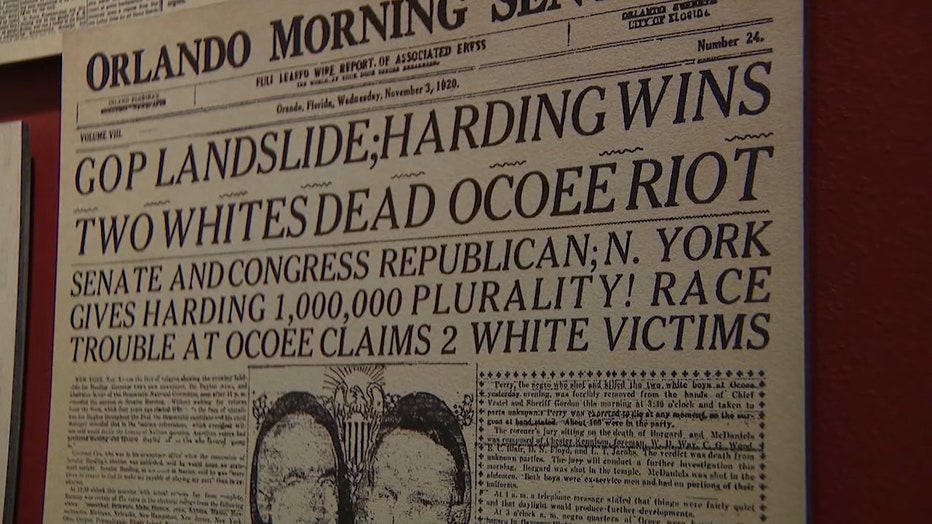
Newspaper clipping following the Election Day Massacre (Orange County Regional History Center)
Despite the lack of historical documents and conflicting accounts, the museum's employees spent endless hours combing through property records, census data, and other official documentation to piece together the jigsaw puzzle that remains incomplete a century later.
But to understand the terror that occurred on that day, it's important to also understand why it was even allowed to manifest. That is essentially the purpose of the exhibit, which opens Oct. 3 in the downtown Orlando museum, ahead of the 100th anniversary. It will be the largest and most comprehensive exhibition on the topic.
"I hope that people can truly understand how long and deep the roots of oppression and racism are in America. I hope that they understand that that history happened here," explained Schwartz. "More people have heard of Rosewood. More people have heard of Tulsa, but that was after this."
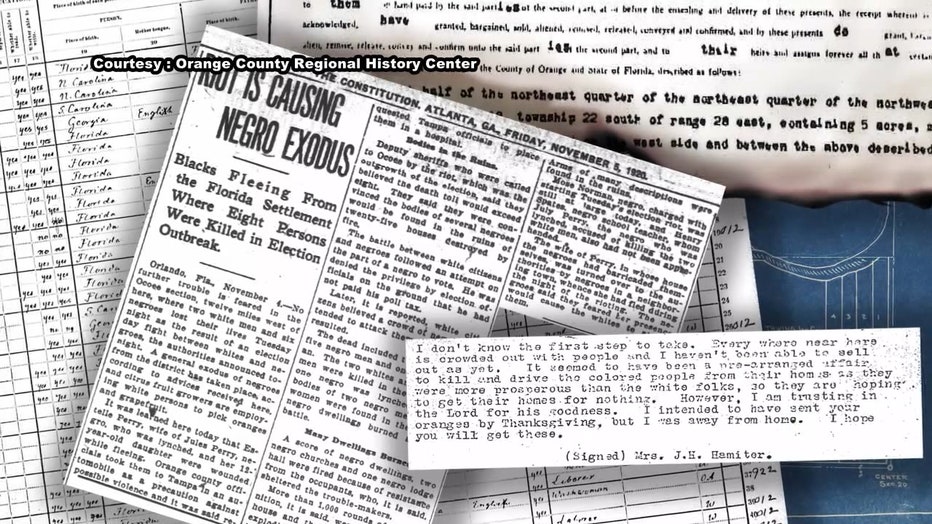
Compilation of newspaper clippings and documents by the Orange County Regional History Center
The exhibit will dive into Florida's history of racism and oppression before and after the Election Day Massacre of 1920, leading up to the modern Black Lives Matter movement.
"We really just want to use this is as a way for people to learn how America got to be where it's at today," Schwartz said, "and what has changed and what has not."
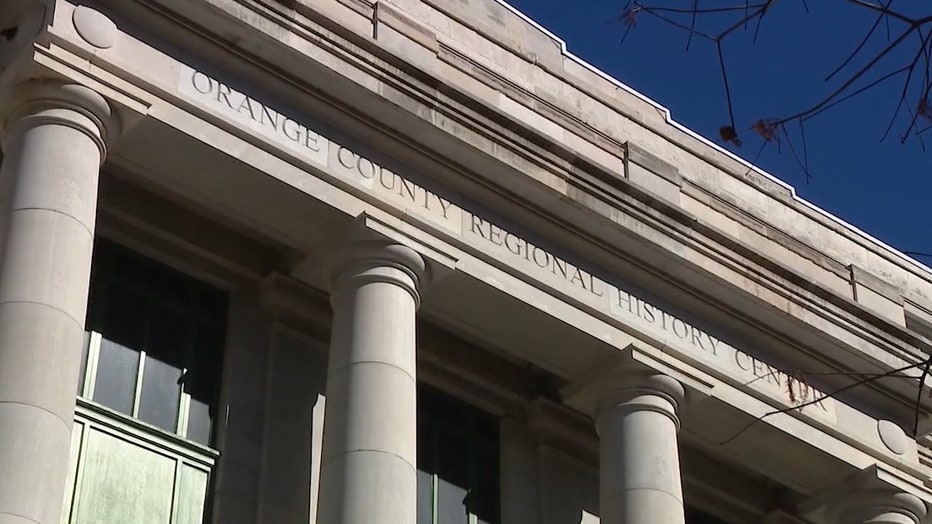
Exterior shot of the Orange County Regional History Center
RACISM IN FLORIDA
The exhibit itself goes back almost 500 years to the first forced enslavement of Africans in Florida.
"It wasn't isolated in a vacuum," Schwartz said. "It was a long time building to the point that this massacre was able to happen."
Visitors will get a run-through of Florida under Spanish rule, up through the Emancipation Proclamation. Those who were formally enslaved were free, but with little and often no education. Many couldn't read or write. They had no money and they had no property.
"Then coming up to the 1920s, you have several things happening that are really really important to the context of our exhibit," Schwartz said. "That includes WWI."

Portrait of unidentified WWI soldier holding a U.S. model 1917 Enfield rifle. (Florida State Library and Archives)
Young Black individuals, especially men, enlisted. In some places, racism was as rampant as it was in America, but in some places, it wasn't. Those individuals got a glimpse of it.
According to the American Battle Monuments Commission, Florida provided over 42,000 to the U.S. armed services during the war. More than 13,000 were African-Americans from Florida.
"Not only did people come home with this renewed interest in equality and having equal rights but they had gone and given up themselves," she said. "They've gone and given themselves to fight for this country with the goal of showing, 'Hey, we see this as our country, we are here to fight as you to save it.'"

Sidney Catts was the 22nd governor of Florida, serving from 1917 to 1921. He publicly called Black residents part of "an inferior race" and refused to criticize two lynchings in 1919. (Florida State Library and Archives)
The exhibit follows this timeline, giving insight into the Jim Crow Laws, WWI and the push for Black voter registration in Florida, as well as the Ku Klux Klan.
At the time, Florida was one of four states that relied on the poll tax to impede black voting. It was one of the first in the nation to adopt it.
"The KKK, a few days before this election, actually had marches throughout Florida," Schwartz said. "We're talking hundreds of KKK members in the streets essentially sharing the sentiment of...If you come out, you'll pay for it. That was sort of the threat."
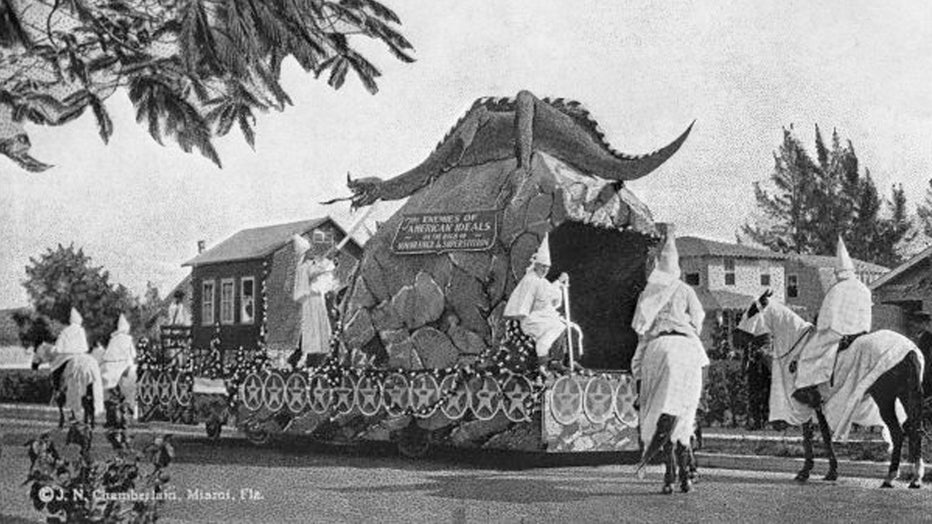
In this 1920 photo, a Ku Klux Klan float is seen in parade along Flager Street in Miami. (Florida State Library and Archives)
The opposing views were brewing and brewing, until it reached a boiling point.
"You're adding a couple degrees of heat to the pot basically every year with these new layers and that's just it," Schwartz said. "The Black community was over it, rightly. They've been over it for a long time."
Blacks in Ocoee were building their own lives and owning their own land, but there were those who were against that prosperity.
The days leading up to Nov. 2 is when things start to get foggy. Two of the main individuals whose name are associated with this event from the Black community are Norman and Perry.
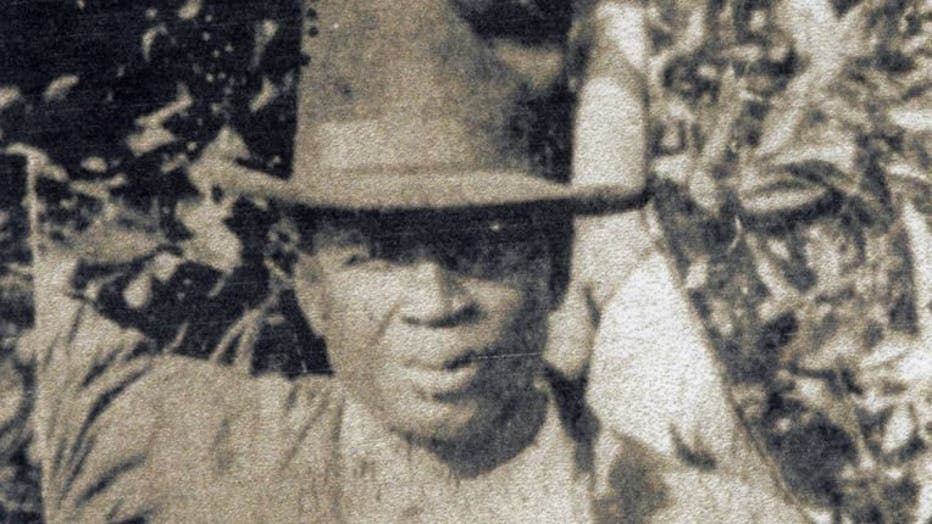
Photo of July Perry (Orange County Regional History Center)
Both were land owners and involved in the community. Norman was known for having a brand-new car in the 1920s, which was a rarity. They were labor brokers -- basically the person between a Black laborer and white employers.
While it's unclear the total number of people who died in the massacre, one thing is certain: there was a deliberate effort to avoid maintaining legal and accurate documentation that would have otherwise shed light on what exactly happened after polls closed.
On Election Day, Norman wanted to vote. There are accounts that say he did pay his poll taxes, while others say he didn't.
Either way, he was turned away. A white mob -- anywhere from six to 100 people -- went to search for him but ended up in a deadly confrontation with July Perry. It's unknown who started the physical altercation.
Ocoee election day riots to be taught in Florida schools
House Bill 1213, signed into Florida law over the summer, will make sure public school students learn about the largest incident of voting day violence in U.S history, which happened in Ocoee and resulted in the lynching of a Black man.
Within a day, at least four Blacks and two white men were killed. Most of the Black community was burnt to the ground -- targeted by white individuals.
The museum doesn't shy away from alternative accounts. They offer the "straight" version, or the version that is officially confirmed from documents.
Visitors will be able to also read other accounts, too, and compare. But one thing they won't see are photos from the Ocoee riot.
"Photography was a thing at the time. There could have been photos," explained Schwartz. "It's pretty evident as you go through all of the documentation that does exist, what should exist and doesn't, that it was as intentional as it was not."
PREVIOUS: Ocoee massacre to be taught in Florida schools, according to newly-signed law
There were no charges following the massacre. To this day, there is no sign of the grand jury report.
"Nobody can seem to find it," Schwartz said. "They should have lived in repository. We actually submitted a FOIA request to try to get the FBI report from the FBI, and they said they didn't have it."
"SAME STRUGGLE. DIFFERENT VERSION"
The terror didn't end after Election Day. In the days and years that followed, the Black community moved away from Ocoee.
"The next year, white men were throwing dynamite in Black families' homes. They're kidnapping Black individuals and beating them and tying them to a fence post," Schwartz said. "And telling them that they've been talking a little bit too much about what happened at Ocoee last November."
There was an ongoing effort, she said, to push all Black families out of the area.
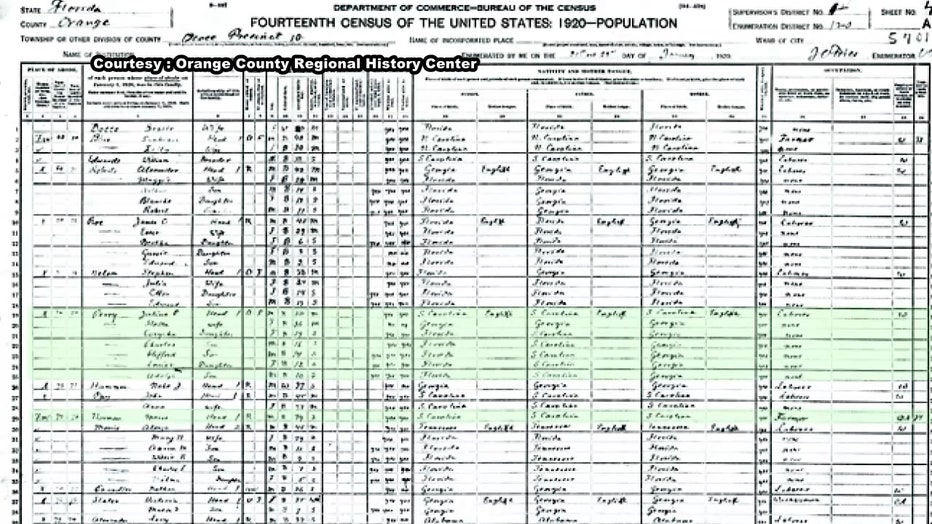
Ocoee's 1920 census shows there were 255 Black individuals living in 78 family units, and there were a total of 560 white individuals on record. By 1930, the census records listed only two Black individuals in Ocoee. (Orange County Regional History C
"A lot of stories have said they left that night, and nobody has ever returned. That's not the case," Schwartz said. "Some people continued to live there more than a year or a couple of years. The last sale of land deed was 1926-27."
As for Perry's family, his daughter and wife were taken to a jail in Tampa, supposedly for their safety.
"They're there for a week," Schwartz said. "When they get out, of course, the whole thing about property and land comes up."
The museum has mapped out those Black owners' properties, based off of land deeds, but it will never be known what they received in return for their land after the Ocoee massacre.
"There are land deeds, but land deeds and the transfer of those don't always show you the full picture. If a land deed says $10 for the sale of this acre, and other valuable considerations, we don't know what those other considerations are," Schwartz said. "It could've been, 'This is $10 to make the deed official. I'm going to give you $200 over here on the sly. Here's $10, I'm going to let you keep your life.'"

Historical marker describes July Perry's death (Orange County Regional History Center)
After Perry's death, a man named Bluford Sims, who sold property to many Black individuals, became the executor of his estate -- not Perry's wife or daughter.
"We will never know actually what the compensation was people received for their property at the time," she added. "It does not change the fact that these people were forcefully and violently removed from their land, their home, their property and any sense of safety and prosperity they have gained at that point."
It would take another 50 years before African-Americans moved back to Ocoee. In the 1970s, a Black individual moved back to Ocoee, a police officer, but he left because he had cross burnings in his lawn.
Schwartz said the exhibit will also include oral histories from descendants of the Ocoee victims.
"They're hardworking, they're entrepreneurs, they're moving and they're shaking, and they're all focused on leading a really wonderful life," she described. "I think there's definitely a legacy left, not only this dark legacy of having this in your family history but there's also the beautiful legacy of people who somehow rose above and beyond this."
‘Unthinkable’: July Perry’s great-niece reflects on Ocoee massacre legacy
In 1920, on Election Day in Ocoee, July Perry was captured, taken to jail, lynched and hanged after another Black man in the community tried to vote. His great-niece, Sha'ron Cooley McWhite, says even though the tragic event occurred a century ago, it still causes her family pain today. 'It’s unthinkable but the most important part is not how he was killed. It’s why he was killed. That’s what we need to talk about.'
The museum will also include a youth and family guide for visitors to help parents and caregivers talk to children about the difficult history.
The exhibit doesn't end on the Ocoee Election Day Massacre. Visitors will move onto learning about Black incarceration, moving Confederate statues, and even the Black Lives Matter movement.
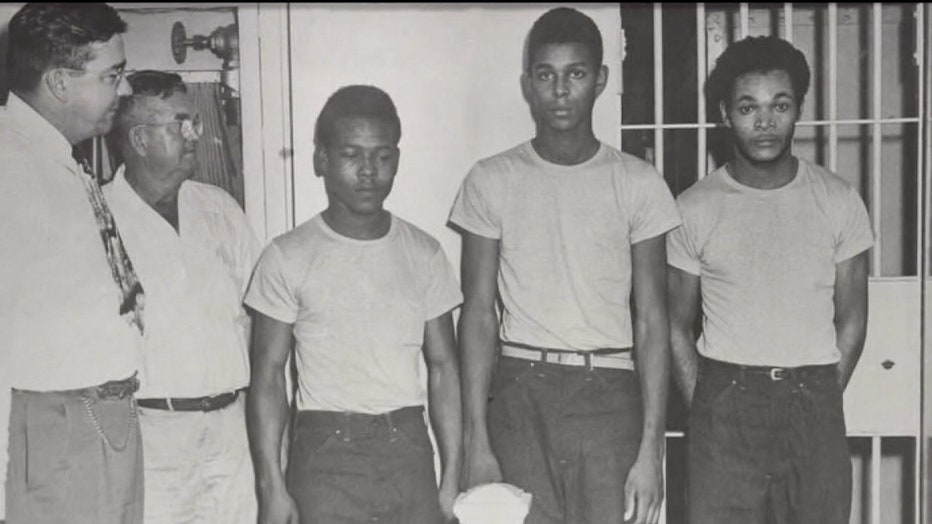
The Groveland Four, Charles Greenlee, Walter Irvin, Samuel Shepherd, and Ernest Thomas, were four African-American men from Lake County who were wrongly accused of raping a woman in 1949. One of them was killed shortly after the arrests. The others w
"In as few of words as possible, we're facing some of the same struggle or different versions of the same struggle that we were seeing 100 years ago when Ocoee happened," Schwartz said. "If you look at the themes: voter rights, gentrification and trying to move people from their home. These issues of people of legal authority and the interactions of law enforcement with the Black community...look at how those themes from 100 years ago and those events reflect on the history we are currently living."

Trayvon Martin was 17 when he was fatally shot in Sanford by George Zimmerman. bringing rise to the Black Lives Matter movement. His death is also highlighted in the exhibit.
"That's why I think it's important to talk about because it's been 100 years. A lot has changed but there's certainly more work to do."
If you're interested in attending the exhibit, you can learn more by visiting the Orange County Regional History Center's website. It will run through Feb. 14, 2021.

